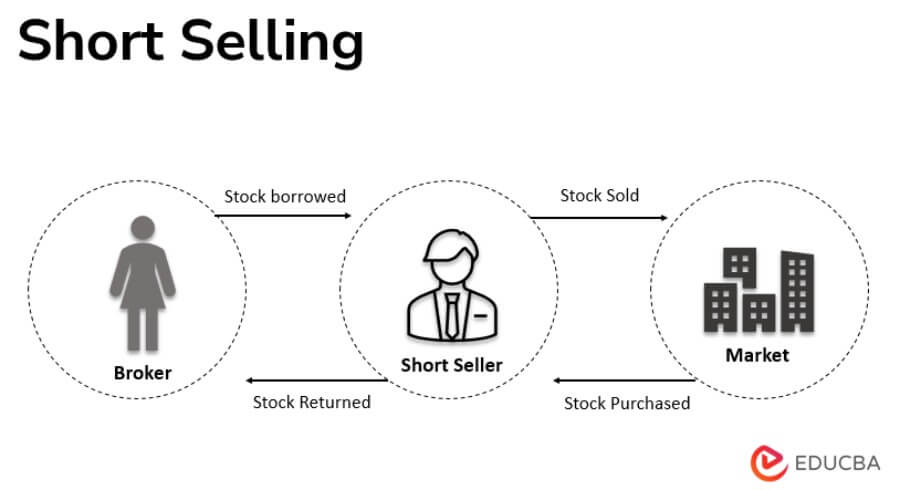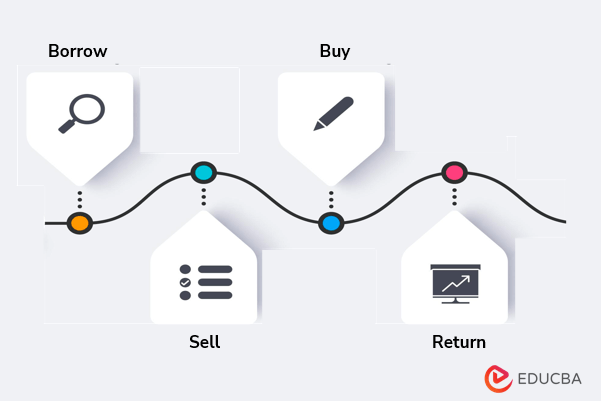Updated July 17, 2023

Introduction of Short Selling
Short selling is an advanced trading technique used by traders or investors, or portfolio managers as a medium of speculation or medium of hedge against downside risk for the same stock or any other, which helps the traders to gain from a decline in the price of the stock from the price at which the stock has been sold.
Explanation
- Let me take you to the layman’s meaning of “short selling.” Suppose you have purchased a stock @ $ 100. After some time, you will sell the stock at a profit/loss. This selling is done after you have purchased the stock (i.e., first, you “bought” the stock, then you “sold” it).
- What if I tell you that you first need to “borrow” the stock from a person for a specified period & then “sell” the store immediately? At the maturity date, you will purchase the stock from the market & return it to the lender. For such lending, you are the lender for “stock lending charges.” It is like taking a loan for a period & repaying the principal amount with interest.
- Thus, average selling means “buy & then sell.” Short selling means “borrow, sell the stock & then buy.”
- Portfolio managers use this strategy to hedge themselves from the downside risk of moving stock prices. Also, speculators used this advanced trading strategy as a medium of speculation & to gain from price movements.
- So, short selling is used for both intra-earners & medium-short term investors.
- So basically, short selling involves a person borrowing stock or any other financial instrument that he believes will observe a decrease in price in the future. So, it is a downside bet.
How Does Short Selling Work?
The flow of short selling can be explained easily through the following steps:
Step 1: Borrow
Here you will first borrow the stock from a lender of stocks. The lender of stocks is typically a big financial institution. You can get these stocks through a stock broker quickly. After you have borrowed the stock, you only have possession of the stock & not its ownership. You must return the stock after the specified period (say two months) along with stock lending charges.
Step 2: Sell
You have to sell the stock which you have borrowed immediately. But one may ask, “how can you sell something you don’t own?” Well, that’s how short selling works. You have to wait until the stock is available at a lower price. But make sure that you have to return the stock within the specified period only (i.e., two months)
Step 3: Buy
If the stock is trading at a lower price than you sold, you should purchase the stock. Here, you earn a gross profit, i.e., selling at a higher price & buying at a lower price. What if the price has not gone down within the specified period? This is the loss situation wherein you must purchase the stock at the maturity date at the available price (which may be higher than what you sold). In this case, you have to suffer gross loss.
Step 4: Return
At maturity, you have to return the stock by buying from the market along with stock lending charges. The lender is not concerned about what price you purchased & returned it. The stock lending charges are deducted from gross profit to reach a net profit due to short-selling transactions.
Example of Short Selling
Say a stock is trading at $ 720 now. The company is about to post its June 2020 quarterly results by the end of the month. Observing the Covid scenarios, the company is expected to publish adverse effects. He wishes to earn by short selling. He expected the fall by a minimum of 15%. He will close the position at a 12% downfall, irrespective of the actual fall later on.
| Current price | $720 |
| Sale price | $720 |
| Number of shares | 100 |
| Deposit with broker | $72,000 |
| Investment | $- |
| Price after one week | $612 |
| Buy price of the trader | $634 |
| Stock lending charges per day | $90 |
Solution:
| Particulars | Amount | |
| A | Selling price | $720 |
| B | Buying price | $634 |
| C | Profit per share (A-B) | $86 |
| D | Number of shares | 100 |
| E | Gross Profit (D*E) | $8,640 |
| F | Number of days until buy | 35 |
| G | Stock lending charges per day | 90 |
| H | Charges paid (F*G) | $3,150 |
| I | Net Profit (E-H) | $5,490 |
Explanation
- If you observe, the investment amount made is NIL (i.e., zero). The deposit is refundable & taken as security.
- The trader will have his bank account credited $ 5490 after deducting nominal broker charges.
Short Selling in Share Market
We will divide our discussion into two practical parts of the share market.
1. Short Selling in Spot Market
Ø The trader first identifies the stock which will decline at least by 2% in the coming period as per the technical analysis. The trader chooses to short the stock by observing parameters such as downside confirmation of indicators, risk & reward strategy holding good, the volume above average, resistance level, etc.
- In the trading platform, you need to sell the stock directly by entering the details such as quantity & price & hit the submit button. This opens a short position for yourself.
- Your expected directional move is a downside. If your stock moves upwards, start making a loss. To avoid risk, it is suggested to specify the amount of loss you can bear, i.e., set the price at which the stock will be automatically bought in the market so that you do not incur more loss due to its upside move.
2. Short Selling in the Futures Market
- The spot market has some restrictions on shorting the stock. There are no such restrictions in the futures market & this is the reason why the futures market is more famous. Futures replicates the movement in stock price & thus, it is a derivative instrument.
- In the future, there is a requirement for a margin deposit. The futures are marked to market daily & adjusted with margin money.
- In a futures market, you short the futures of the said stock & this makes it more volatile. Futures & Options are volatile by nature. This will amplify your return, whether positive or negative.
Advantages
Some of the advantages are given below:
- The most significant advantage is earning profits without owning the stock.
- They earn the difference in prices directly without making any investment. Thus, there is no or minimal investment.
- You are liable to pay only the stock lending charges, which are minimal.
- Since short selling uses margins, this multiplies the returns you earn.
- It is easy to conduct short selling by opening a trading account with a stock broker & you do not need to search for a lender.
- In case of multiple bad news, the stock price can move downside substantially & which can multiply your profits.
- This is the bread & butter for speculators.
Disadvantages
Some of the disadvantages are given below:
- As you know, short selling can be done only for a specified time (usually less than six months). You cannot hold the temporary open position for life long & wait for the downside of the stock.
- Whatever the price, at maturity, you have to return the stock. Most stock brokers automate this process to ensure stock delivery to the lender on the maturity date. So, you have booked a loss if such stock is available at a high price on maturity.
- You have to pay stock lending charges for the period of holding. Some brokers charge hidden fees for such transactions. So, a trader needs to be aware of the same.
- You must transfer the dividend amount to the stock owner if a dividend has been earned.
- The stock lender may demand the stock before the maturity date & no one can stop him. In such case, you are required to purchase the stock & return the same to the lender at any cost. This is the most significant risk with short-selling transactions. Thus, an explicit agreement is necessary.
- Stocks usually do not fall below their actual price. Even if it fails, it bounces back rapidly. Thus, the stock can naturally move upside down without any limit. This means there is no limit on how much loss you may have to book during the lending period.
Conclusion
Short selling is viewed differently by speculators, traders & investors. It has high magnified returns. By returns, we mean both upside & downside returns. So, it depends on the risk appetite of the person. High-risk takers are rewarded highly. Short selling is a transient phenomenon in terms period of lending concerned. Thus, investors prefer short selling only for a short duration of time.
Recommended Articles
This is a guide to Short Selling. Here we also discuss the introduction, how short-selling works, and its advantages and disadvantages. You may also have a look at the following articles to learn more –



